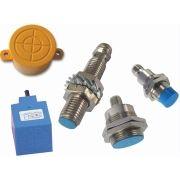 Add My Company
Add My Company
Sign In

Introducing our Inductive and Capacitive Sensors Line
Inductive Sensors
The sensor consists of an induction loop. Electric current generates a magnetic field, which collapses generating a current that falls asymptotically toward zero from its initial level when the input electricity ceases. The inductance of the loop changes according to the material inside it and since metals are much more effective inductors than other materials the presence of metal increases the current flowing through the loop. This change can be detected by sensing circuitry, which can signal to some other device whenever metal is detected. Common applications of inductive sensors include metal detectors, traffic lights, car washes, and a host of automated industrial processes.
It is particularly useful for applications where access presents challenges or where dirt is prevalent because the sensor does not require physical contact. The sensing range is rarely greater than 6cm, however, and it has no directionality.
Other applications for Inductive sensors include:
- Machine position processing sensing (i.e. robot arm position)
- Detection of processed metal parts in heavy industry
In capacitive proximity sensors, the sensed object changes the dielectric constant between two plates. A proximity sensor has a range , which is usually quoted relative to water. Because changes in capacitance take a relatively long time to detect, the upper switching range of a proximity sensor is about 50 Hz. The proximity sensor is often found in bulk-handling machines, level detectors, and package detection. One advantage of capacitive proximity sensors is that they are unaffected by dust or opaque containers, allowing them to replace optical devices.
A typical capacitive proximity sensor has a 10-mm sensing range and is 30 mm in diameter.
The proximity sensor incorporates a potentiometer to allow fine tuning of the sensing range and can repetitively detect objects within 0.01 mm of the set point. Switching frequency is 10 Hz, and operating temperature range is -14 to 158°F.
Other applications for Capacitive sensors include:
- Detect defect parts on production line
- Parts counting
- Liquid level detection
Nick Gilbert
Operations Manager
Assemtech Europe Limited
www.assemtech.co.uk
For more information on Introducing our Inductive and Capacitive Sensors talk to Comus Europe Ltd (formerly Assemtech)
Enquire Now
List your company on FindTheNeedle.
